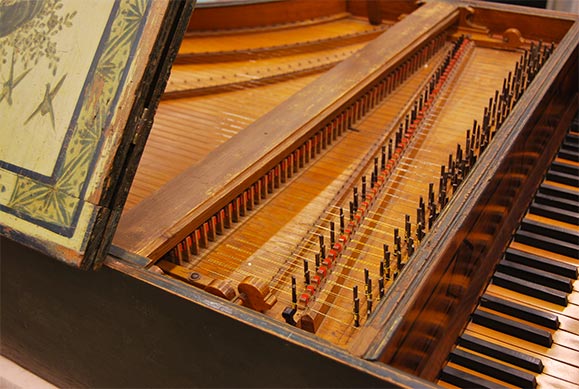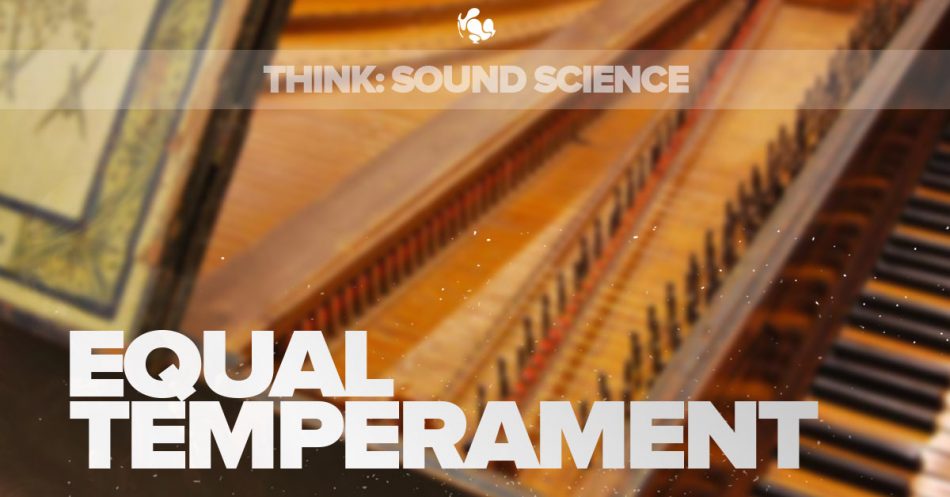A lesson on the science of sound
I imagine a good percentage of musicians have heard of equal temperament, but not too many properly understand what it is, when it came about or why we use it. In my experience, the average musician will maybe know that we use it, but that’s about it.
I first became aware of it when I was having harpsichord lessons at University (probably one of the most frightfully British-middle-class sentences ever composed… I’m sorry), when the teacher explained to me that if we tuned the harpsichord in fifths from the bottom up it would be out of tune with the octaves. He also described this phenomenon rather enigmatically as the ‘Pythagorean Comma’. It’s safe to say I didn’t have a clue as to what he was talking about.
Years passed, and it bothered me that I still didn’t understand why this would be the case. Now I understand, it’s actually quite simple. By the end of this blog, hopefully you’ll understand it too. I promise, it’s easier than you might think. But you will have to pay attention! Don’t let the sight of maths put you off.

As most of you will know, sound is caused by vibration, and the faster the vibration, the higher the sound. For example, the A above middle C that we hear orchestras tune to is 440 vibrations per second. The amount of vibrations that happen per second is measured in Hertz. So, that A is 440 Hertz.
Here’s another important fact: If you double the frequency of vibrations of a particular pitch, you increase it by an octave. So if our standard concert A is 440 Hertz, the A above it is 880 Hertz, the one above that is 1760 etc. It follows that the A below concert A is 220 Hertz, and the one below that 110 Hertz etc.
Because sound is measured numerically in vibrations per second, two sounds of different pitch can be expressed as a ratio (this may sound difficult, but stick with it, it’s actually easy to understand). What do I mean by this? If in an octave the higher note is exactly twice the Hertz, then an octave can be expressed as a 2 to 1 ratio, because for every one vibration of the lower note there are two of the higher note. And every interval has its own unique ratio. For example, the interval of a major 3rd has a ratio of 5 to 4. This means that if the bottom note was 100 Hertz, the top note would be 125 Hertz. See, like I said it’s quite easy.
But here’s where the problem comes in. These ratios won’t fit together. The maths simply won’t allow it! But why on earth not? This is where things get a little trickier (but only a little I swear). Let’s use our major 3rd as an example.
As we have just learned, a major 3rd has a ratio of 5 to 4. So if the bottom note in the interval vibrates 4 times, the top note vibrates 5 times (in the same amount of time). We’ve also learnt that in an octave the frequency is perfectly double, so there is a ratio of 2 to 1 between the top and bottom notes in the interval. An octave is the equivalent distance of three major 3rds; if you stack three major 3rds on top of each other, you get an octave. For example, C to E to G sharp/A flat to C again. But here’s the problem: 5/4 x 5/4 x 5/4 does not equal 2/1. It falls slightly short. 5 x 5 x 5 = 125, and 4 x 4 x 4 equals 64. This means the ratio is 125 to 64. For this to be equivalent to 2/1, it would have to be 128 to 64. It doesn’t perfectly double, which is what we would need to get it in tune with our octave.
You could also think of it this way: 5/4 is the same as 1.25 over 1, and 1.25 x 1.25 x 1.25 equals 1.953125. You can see that this falls short of doubling the bottom number, which would be 2, which is what we would need to make an octave. So three perfectly tuned major 3rds make an out-of-tune octave. You can make your C perfectly in tune with E, and E with G sharp, and G sharp/A flat with C, but the two Cs will be out of tune. And because out of tune octaves sound so horrendously bad, we knock all the major 3rds slightly out of tune to get the octaves right. Just as we temper steel to make it more malleable, we temper our music to make it more malleable too.
The same is true with other intervals. A perfect 5th has a ratio of 3 to 2. If you start on the bottom A on a piano and tune up in perfect 5ths, by the time you reach the A at the end seven octaves away (equivalent to 12 fifths) it will be out of tune, because 3/2, like 5/4, just won’t nest within 2/1, and this discrepancy between tuning in fifths and octaves is the Pythagorean comma.
People have known about this problem for a while (hence it being the ‘Pythagorean’ comma, because it was known to Pythagoras). But in the past, music didn’t move between keys as much as it does today. In very early music (way before the Classical era of Mozart and Haydn), they generally stuck to one key or mode for an entire song, and it’s easier to have an instrument more in-tune in one key, so this wasn’t such a big deal. To have an instrument very in-tune in one key will make it more out of tune in another. An instrument suited to one key in this fashion is said to be in ‘mean tone’ or ‘just’ temperament. This will result in very consonant intervals between some notes and very dissonant intervals between others.
Because we want our modern instruments like pianos to work in all keys, we divide the dissonance up between all keys equally. This is why it’s called ‘equal’ temperament. Each semitone is roughly 5.9 percent higher than the last.
Here’s a fun fact: One of the first people in the West to strongly advocate for the universal use of equal temperament was Vincenzo Galilei, a 16th century music theorist, one of the inventors of opera and father of Galileo.
In the Baroque and Classical eras, the dissonance was divided between the keys, but not always equally. Some keys got more of a share of the Wolf interval than others (the more dissonant intervals were called Wolf Intervals because the sound reminded people of the howling of wolves). This meant keys had different sounds or colours to them, because they did actually have different frequency ratios between the notes. So when composers like Beethoven talked of key colours and how the keys had different feeling associated with them, there was a real scientific basis for it, not just personal preference.
Because we use equal temperament, we miss out on not just key colours but on more consonant harmony. We now very rarely hear pure 3rds and 5ths, and instead hear slightly out-of-tune ones. Because of this, some people lament the use of equal temperament, but overall it has made things so much easier it is probably worth the sacrifice.
If you enjoyed this lesson, make sure you check out our other blogs, and stay tuned for further lessons. If you’re serious about furthering your knowledge and your career in music, check out our Postgraduate and Premium courses on our website and see which ones are suitable for you. We’re always happy to help, so send us an email at contact@thinkspace.ac.uk with any questions and we’ll get back to you.

